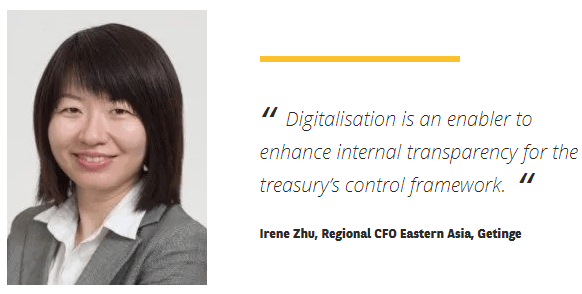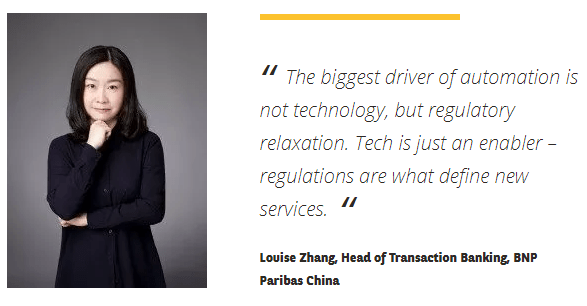Covid-19 and regulatory changes are accelerating the digitalisation of treasury processes in China.
For multinational corporations (MNCs) with operations in mainland China, the pursuit of more efficient cash management processes was already underway before the onset of Covid-19. However, travel restrictions and supply chain disruptions stemming from Covid-19 have catalysed this trend and underlined the case for the digitalisation of payments and cash management processes.
The impact of the pandemic is also encouraging MNCs to embrace innovation to find new solutions to long-standing issues. In some sectors, Covid-19 boosted cash and working capital following a sharp rise in demand and buyers willing to pay in advance.
However, during the first lockdown in early 2020, cash flow rapidly became a challenge for companies in many other sectors. As businesses activities came to a halt, liquidity was impacted, with firms unable to sell and collect money from customers, all while payables sitting on the balance sheet became due.
The push for simplification
Liquidity management in China is made all the more challenging by complex corporate structures and segregated bank accounts. Companies generally have a principal account for day-to-day transactions. In some regions, the authorities mandate which bank a local subsidiary must use, resulting in a complex web of accounts.
Technology is a key part of the push for simplification, and many companies were already upgrading their treasury technology in advance of the pandemic.

“We were engaged in finding ways to reduce the number of accounts we had,” said Irene Zhu, Regional CFO Eastern Asia at Getinge, a global medical technology company. “Digitalisation is an enabler to enhance internal transparency for the treasury’s control framework.”
Knorr-Bremse APAC, a manufacturer of braking components for trains and heavy vehicles, also had an automation project, focusing on booking of collections and reducing bank accounts. While Covid-19 highlighted the need for better technology. Ernest Mui, Director – Treasury and Tax at the company said, “Globally, Covid accelerated digitalisation because so many people had to work from home.”
Regulation drives automation
China’s regulators have taken action to ease some of these problems with new rules around corporate structures and digital payments. These rule changes are allowing global companies to reduce complexity and explore new solutions, such as cash pooling.
“The biggest driver of automation is not technology, but regulatory relaxation,” said Louise Zhang, Head of Transaction Banking at BNP Paribas China. “Tech is just an enabler – regulations are what define new services.”

Knorr-Bremse’s Mui underlined the impact on corporate structures: “new regulations have enabled digital payments and collections to be rolled out nationwide.”
Zhang also points to how regulations are making it easier for companies to manage cash reserves, a long-standing problem for MNCs in China: “One of the persistent situations our clients want help solving is trapped cash. Listed subsidiaries and other local entities are not easily able to expatriate surplus cash, so they need to find ways to either use it in-country, or move it overseas legally.”
The People’s Bank of China (PBoC) and the State Administration of Foreign Exchange (SAFE) are addressing this issue by expanding cross-border cash pooling regulations to multiple currencies, which Zhang believes will be a boon to MNCs’ subsidiaries in China. “Not only will it enable sweeping, which helps resolve complex corporate structures, but it also supports automation between local accounts and local cash pool, enhancing efficiency,” she said.
Carlsberg is working on a related project, according to Inga Kudzmaite, Regional Treasury Director for APAC at the beverage giant. “Our operations in China already has a domestic centralised cash pool but have to accommodate for the need of different local banks where we still use manual processing,” she said. “We want to use sweeping so we can further centralise the liquidity and manage cash balances more efficiently by automatically transferring surpluses into interest-bearing accounts or for placing investments. Moreover, reducing manual processing is just equally important.”
BAD gets better
Similarly, regulation has driven rapid progress in the evolution of the Bank Acceptance Draft (BAD). Similar to a bill of exchange, a BAD is a time draft guaranteed by the bank rather than by the corporate, representing a promise of future payment that can be held to maturity, or sold at a discount to release liquidity.
“Because of the lack of liquidity in the early stages of the pandemic, we received more BADs recently, meaning we had to rely on banks to collect and handle for us,” said Mui. “But with greater electronification, we are able to handle these better.”
The PBoC has introduced regulations and guidance for the new generation of the electronic BAD (EBAD), which will go live next year or 2023.
“It’s a completely new system that will help clients with their liquidity challenges,” said Zhang. “BADs are normally a separate process from other payments. However, new features like transferring split draft amount to suppliers will allow corporates to integrate the BAD payments and collections with normal wire transfers, simplifying cash flow oversight and control.”
More change is coming
Perhaps the most anticipated regulator-driven initiative is the PBoC’s proposal to introduce its own digital currency – the e-renminbi (eRMB). It will be based on smart contracts and recorded on a blockchain, streamlining payments and reconciliation processes.
For global businesses, China’s embrace of digitalisation means greater visibility, simpler processes and allows better use of idle cash. As treasurers shift their focus from short-term liquidity to long-term opportunity, the changes made during the pandemic are sure to have a lasting impact.
This article is an excerpt of The Asset webinar Changing China: Embracing innovation to build better treasury. Check the full webinar down below.

